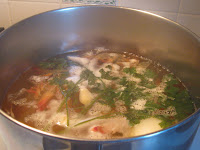Taking a cue from England, New Englanders have traditionally enjoyed a warm pudding for Christmas. In my household, it's chocolate bread pudding. Now, it's important to note that the Pilgrims didn't celebrate Christmas and didn't have access to chocolate. But they did enjoy bread pudding. In fact, after his first wife jumped ship (some claim she fell) and drowned in the icy waters of the Atlantic, as the Mayflower was anchored off the coast of Provincetown, Gov. William Bradford married Alice Southworth, who became known for her plum pudding, according to the Plymouth Antiquarian Society's Plimoth Colony Cook Book. The pudding was made with bread, milk, eggs, molasses, raisins, currents, citron and candied cherries. Southworth came to Plymouth on the ship "Anne" in 1623.
According to Colonial Williamsburg, the first reference to chocolate in North America occurs in 1641, when the Spanish ship Nuestra Senora del Rosario del Carmen arrived in St. Augustine, Florida with crates of chocolate. In 1670, Dorothy Jones and Jane Barnard opened a public house in Boston to sell imported chocolate. By 1682, a British report detailed cocoa exports from Jamaica to Boston. And we know that early Patriots drank hot chocolate instead of tea to protest taxation without representation.
This recipe for chocolate bread pudding comes from the Gourmet Touch Cookbook by Naomi Arbit and June Turner, published in 1978. The pudding is homely but decadently delicious, especially served with real whipped cream.
According to Colonial Williamsburg, the first reference to chocolate in North America occurs in 1641, when the Spanish ship Nuestra Senora del Rosario del Carmen arrived in St. Augustine, Florida with crates of chocolate. In 1670, Dorothy Jones and Jane Barnard opened a public house in Boston to sell imported chocolate. By 1682, a British report detailed cocoa exports from Jamaica to Boston. And we know that early Patriots drank hot chocolate instead of tea to protest taxation without representation.
This recipe for chocolate bread pudding comes from the Gourmet Touch Cookbook by Naomi Arbit and June Turner, published in 1978. The pudding is homely but decadently delicious, especially served with real whipped cream.
Chocolate Bread Pudding
5 slices white bread, cubed
6 ounces chocolate chips
½ teaspoon cinnamon
1-1/2 cups milk
½ cup sugar
¼ cup butter
¼ teaspoon salt
2 eggs, well beaten
Lightly grease a 1-1/2-quart casserole. In a large bowl, combine bread cubes, chocolate chips and cinnamon. In a sauce pan, heat milk, sugar, butter and salt, bringing to a boil at medium heat. Remove from heat. Stir two tablespoons of hot milk mixture into beaten eggs to temper. Quickly beat eggs into remaining milk mixture. Combine milk-egg mixture with chocolate and bread cubes; stir to coat. Pour into casserole. Place casserole in a baking pan filled with a half-inch to an inch of hot water. Bake in a 350-degree oven 40 to 50 minutes. Serve warm with whipped cream, if desired. Serves six.






































